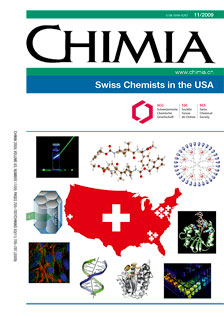Novel Antennae for Luminescent Lanthanide Cations Emitting in the Visible and in the Near-Infrared: From Small Molecules to Polymetallic Lanthanide Containing Nanocrystals
DOI:
https://doi.org/10.2533/chimia.2009.745Keywords:
Antenna, Dendrimer, Energy transfer, Lanthanide luminescence, Nanocrystals, Near-infrared, Metal-organic frameworksAbstract
Lanthanide cations have advantageous luminescence properties in the visible and in the near-infrared, such as high resistance to photobleaching which is a desirable property allowing long exposure of lanthanide compounds to excitation light without loss of luminescence intensity, and sharp emission bands whose wavelengths are not affected by experimental conditions, enabling efficient spectral discrimination from background fluorescence. Lanthanide cations also have long luminescence lifetimes that allow for temporal discrimination between sample and background. Due to these unique properties, lanthanide compounds could fulfill the requirements of luminescent reporters and sensors to be used in a broad range of applications, including biological analysis and biologic imaging. Free luminescent lanthanide cations have very limited absorption since f–f transitions are forbidden. To overcome this limitation and to take advantage of their luminescence properties, lanthanide cations need to be located at close proximity to a sensitizer in order to generate an 'antenna' effect. In this review, we present and discuss different strategies and chemical systems that have been created and studied in the Petoud group in the Department of Chemistry of the University of Pittsburgh in order to develop novel antennae for lanthanide cations emitting in the visible and in the near-infrared. Two main avenues have been tested: a) The formation of luminescent monometallic lanthanide complexes using sensitizers based on derivatives of i) tropolonate, ii) azulene, iii) pyridine and iv) fluorene oligomers. b) The synthesis of systems where the number of lanthanide cations and the absorbance are maximized in order to enhance the number of photons per unit of volume in order to promote detection sensitivity. Different chemical approaches have been used to explore this strategy: i) polymetallic dendrimer complexes, ii) lanthanide containing semi-conductor CdSe nanocrystals, iii) tropolonate coated Ln3+-Doped NaYF4 nanocrystals and iv) metal-organic frameworks for polymetallic lanthanide complexes.Downloads
Published
2009-11-27
Issue
Section
Scientific Articles
License
Copyright (c) 2009 Swiss Chemical Society

This work is licensed under a Creative Commons Attribution-NonCommercial 4.0 International License.
How to Cite
[1]
Chimia 2009, 63, 745, DOI: 10.2533/chimia.2009.745.







